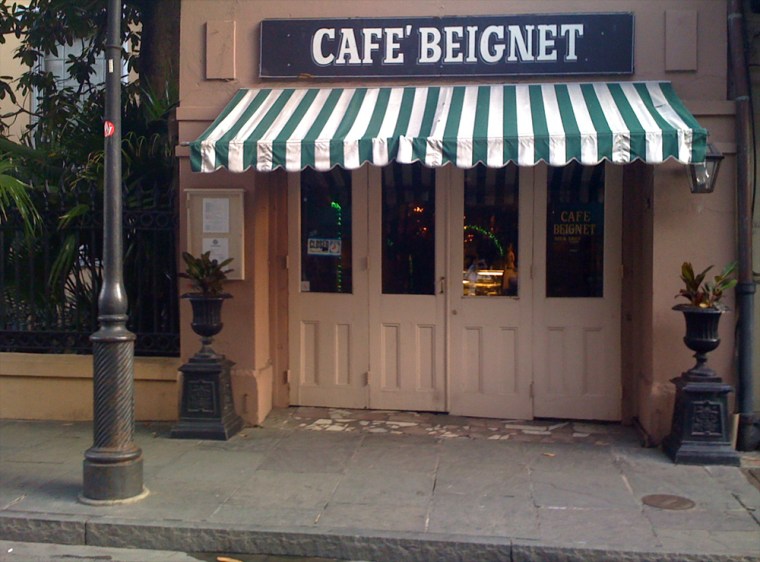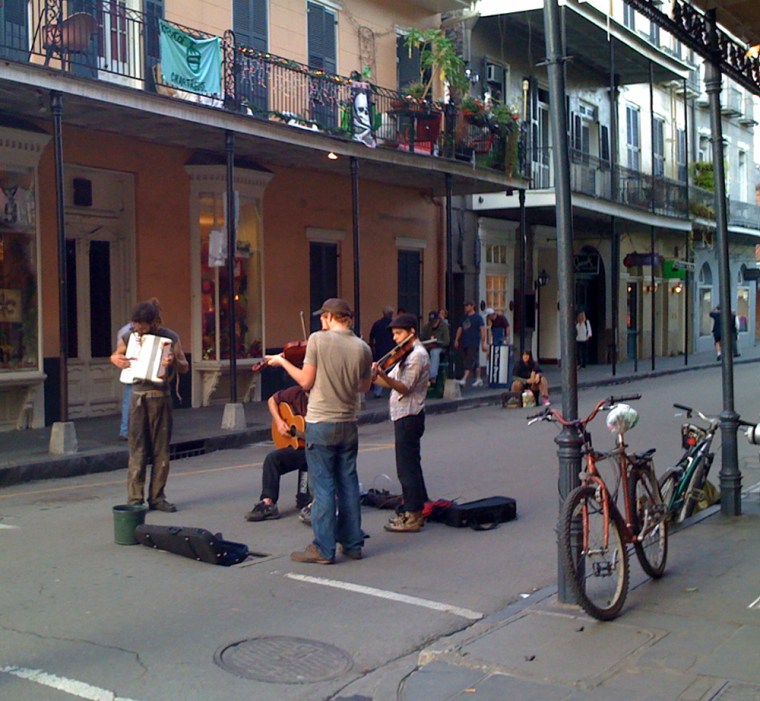If my family were totally honest we would admit that food is our religion. It’s our most important pastime, our biggest obsession and greatest source of pleasure and strife. Food was the biggest reason our disparate clan put down roots in New Orleans, a place that has transformed food, drink and generally carrying on into high art.
I first visited New Orleans around 20 years ago, when my brother was in college there. He picked me up at the airport in a red and white 1976 Oldsmobile Delta convertible — the top didn’t work and he got wet often. The floor was worn through in places so the road zipped past just below our feet.
We soon stopped at a drive-through daiquiri place. Yes, real, alcoholic daiquiris — the argument was that the lidded cups weren’t open containers since the straw was separate.
My brother also took me to Café du Monde, where we ate fried fritters called beignets coated in powdered sugar. They were astoundingly delicious. We danced until the wee hours in Tipitinas, where New Orleans’ — and some of the country’s — finest musicians played.
Always careful to be the good tour guide, my brother introduced me to po’ boy and muffaletta sandwiches, boiled crawfish and jambalaya. The unique flavors stuck and I was hooked on the city.
It is no surprise, then, that I trace New Orleans’ fitful recovery from Hurricane Katrina by watching its food and restaurants.
Things did not look good when I first went back three months after Katrina. Customers and workers were flung across the country and most of New Orleans’ restaurants stood shuttered. But slowly, and sometimes not so slowly, parts of the city got eating.
Sneaking by checkpoints
Donald Link, a Louisiana native and the owner and chef at one my favorite restaurants, Herbsaint, dared to return to New Orleans just 10 days after the devastating 2005 storm to take stock of the damage.
“My father-in-law and I made up some passes, something that looked official, which we just kind of laminated,” Link says. “We had to sneak our way past a few checkpoints,” the 39-year-old says casually.
Feeding his employees was his first priority and about five weeks after the storm, he reopened with nearly all of his 45-strong staff on hand, Link says. Despite dire expectations, business has been really good: Link has opened three more businesses since Katrina and now employs around 100 people.
Tradition and innovation
Food feeds New Orleans. When you meet your friends out, they will often ask what and where you last ate. They will then proceed to tell you in careful detail where and what they ate.
New Orleans’ food obsession fits my family’s personality. It is a place to slurp down smoky gumbo and freshly shucked oysters doused in Tabasco sauce, savor crawfish etouffee, shrimp remoulade and turtle soup.
These dishes may sound exotic but are based largely on uniquely American traditions, Creole and Cajun cooking. The Creoles were descended from European planters and cooks dipped deeply into French and Spanish recipes. Traditional Creole dishes tend to be elegant and, as my dad says, “saucy.” Today, Creole often refers to people whose heritage reflects the city’s jumbled genealogy — be it Native American, French, Spanish, Italian, African or English.
That is not to say that all good food in New Orleans is Creole, or Cajun — a simpler, spicier cuisine known for its dishes made in one pot. New Orleanians are so interested in food they’ve absorbed culinary traditions from a series of immigrant groups, or just riffed off of what’s at hand.
But whatever New Orleans cooking is, exactly, connoisseurs say it is distinct.
“There is a definite common flavor profile in other cities. Then I come home and I say, ‘This is different, this is very different,’ ” Link says.
Link bases his work on what he learned growing up in Louisiana, where he didn’t go to restaurants, but rather watched his grandfather cook. To him, as for many others in the neighborhood, food and family are intertwined.
“Here, nobody’s more than 10 minutes from each other,” he says. “My kids go to school with other chefs’ kids. It’s important to me.”
Food and family
Food and family, that’s what it’s like in New Orleans. The two are of-a-piece for me too because the city is still home to my brother, who now lives there with his wife and their two little girls.
So when Katrina hit I fretted selfishly about the storm’s impact on their lives — and not a little on the New Orleans I’ve come to regard as a sort of a home away from home. I relaxed when the news came that the storm had sideswiped but not devastated the city. I watched in disbelief after the levees broke and the waters rose and rose, flooding most of the city. And I raged as officials argued while countless lives were destroyed.
My brother’s family lived in a part of town that was spared the disastrous flooding. After a stint in Houston and through much effort and sacrifice, they returned to a city that some people were happy to write off. Many have not been this fortunate — an estimated 30 percent of New Orleans’ residents simply cannot go home. Once-thriving neighborhoods still lie bereft of people and houses.
But my family is very lucky and has once again laid claim to its small corner of New Orleans. My parents cheered when their favorite supermarket, Langenstein’s, reopened after the storm. It was a natural, if very expensive, decision to hold a surprise dinner for my dad’s 70th birthday at legendary Galatoires in the French Quarter.
Forget café — try cochon au lait
It doesn’t need to be a special occasion to eat special in New Orleans — eating is the occasion.
In plain but quirky Casamento's, in Uptown New Orleans, perfectly coifed women in cashmere sweaters wait to be seated alongside students in flip-flops and men in paint-stained jeans. Established in 1919 by an Italian immigrant, it serves raw oysters, oyster stew and oyster loaf — think a thick sandwich stuffed to bursting with fried oysters.
There’s non-oyster stuff in Casamento’s too, such as fried soft-shell crab, spaghetti and meatballs, and gumbo, a strong, dark stew that varies according to where and when it’s cooked. The last time I was in there it had tiny shrimp, sausage and okra, a vegetable that African slaves first brought to the Americas.
On another afternoon, I discussed the city’s recovery with an old friend and New Orleans native over pomegranate mojitos, cochon au lait (suckling pig) and oysters baked with cream spinach at Café Amelie in the French Quarter. She suggested that the city’s health could be traced through its communities and families.
“It will be people like them,” she said gesturing toward two tables in front of us, where groups of people ate and laughed. They could have been locals or tourists, but it didn’t matter, she says. This conviviality brought back a bit of the carefree, pre-storm New Orleans, and will build it anew, she believes.
Soon we, too, laughed, ate and drank in Amelie’s romantic secluded patio, nourished by the moment and perhaps trying to forget a bit of the past.

Rio Mar, a Latin-infused seafood restaurant in the city’s warehouse district is not traditional “New Orleans,” but that does not mean you shouldn’t go.
We ordered tapas for lunch and so ate too many dishes to recount here. The standouts were the shrimp, octopus and whitefish ceviche (very spicy and tasty), and mussels in chorizo, which was excellent as the sausage’s classically strong and peppery flavor did not overwhelm the seafood.
Commander’s Palace is a grand restaurant to visit if you feel like it is an occasion. On a pretty street facing an old cemetery in the Garden district, it specializes in its own versions of New Orleans classics. A friend of mine, a local regular, swears by the Turtle Soup au Sherry. But what he really raves about is the Commander’s wine list.
Times, and lives, change
The brother who picked me up at the beginning of my last trip in December drove a Jeep Cherokee. Two child seats sat in the backseat of his car, the roof functioned and I couldn’t see any asphalt under my feet.
Our first stop was my brother’s house where two screaming girls, Honey the guinea pig and pizza greeted me (we would eat out in later meals).
And while Café du Monde, Tipitinas and drive-through daiquiri joints don’t feature in my visits these days, I’m comforted by the knowledge that New Orleans is carrying on, one way or another.
It is extremely difficult to tailor a list of restaurants in New Orleans, and it is worth investigating because there is an unusually large scope. Here are just a few more ideas:
- August
- Bayona
- Brigtsen’s
- Clancy’s
- Cochon
- Domilise’s Po-Boys
- Emeril’s
- Ignatius Eatery
- Jacques-Imo's Cafe
- K-Paul’s
- La Petite Grocery
- Lillette
- Mandina’s
- Napoleon House
- Pascal's Manale
- Stella
- Upperline
